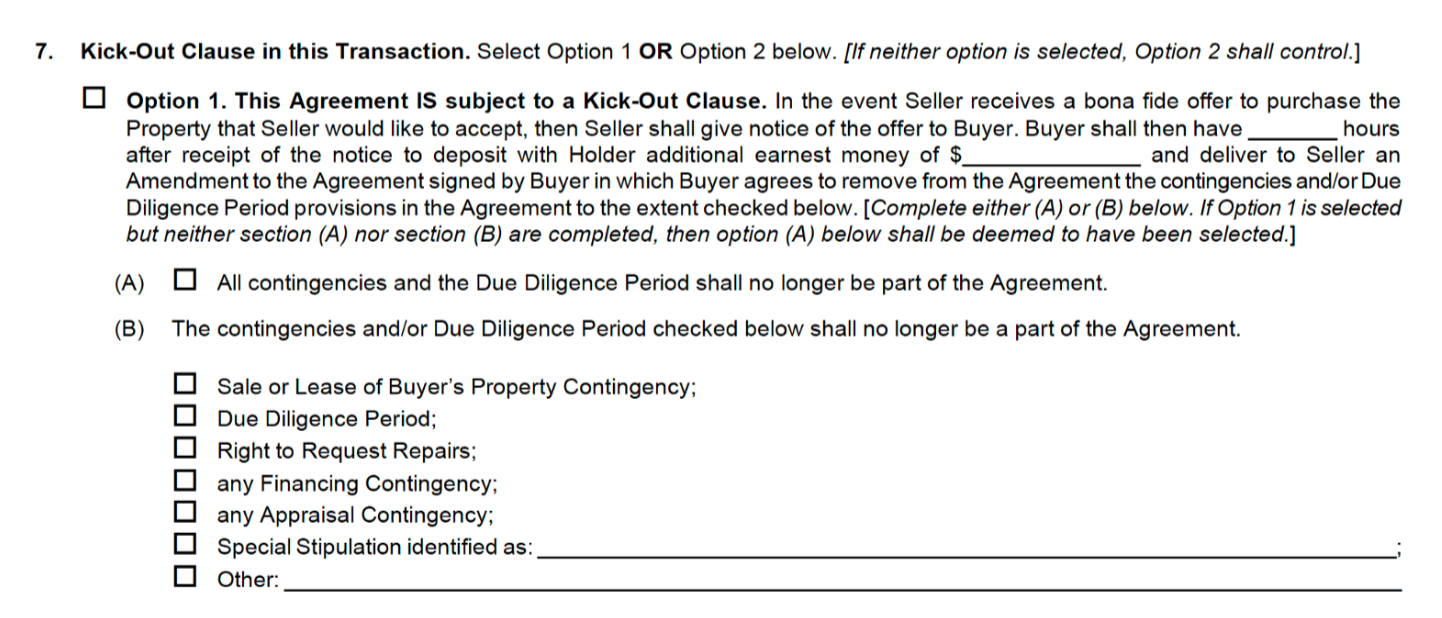|
The Sale or Lease of Property Contingency is quite flexible and can be used to either the buyer’s or the seller’s advantage, depending on the market and the situation. Part 1 of the discussion of the Sale or Lease of Property Contingency included various options or advantages available to the buyer and seller in the contingency as well as the process required to exercise the kick out clause. Drilling a bit deeper, the GAR form contemplates termination of a contingency contract in 2 ways: 1) Exercise of the Kick Out Clause and 2) Expiration of the Contingency Period. The Kick Out Clause Section 7 of the sale or lease contingency presents alternatives as to whether some or none of the contingencies in the contract remain in place. This can be confusing, so here’s the simple explanation by way of different scenarios. Scenario 1 Contract 1, fully executed, includes a sale or lease contingency with a 24 hour kick out clause. Contract 2, a bona fide offer, comes along and Seller wants to accept it, so Seller sends a 24-hour Notice to Buyer 1 to remove the Kick Out by amendment or Seller can terminate. Buyer 1 thinks the deal is great and that his current house will sell quickly, so, wanting to hold on to the house, Buyer 1 delivers an amendment to the Seller, agreeing to remove the contingencies and due diligence period that Buyer 1 agreed to in the original contract. In this case, the Buyer had agreed to section (A) in the purchase agreement, so the amendment says that all contingencies and the Due Diligence Period are removed from the contract. The sale becomes an all-cash transaction with the Buyer’s earnest money at risk. Scenario 2 In this scenario, the buyer chose alternative (B), but marked that only the Sale or Lease Contingency would be removed from the contract. The Due Diligence Period, the Right to Request Repairs, the Financing Contingency and the Appraisal Contingency are still in the contract. If timing is appropriate and the financing fails, the appraisal is low or there is still time to terminate in the Due Diligence Period, the buyer can still exercise his rights under those provisions. Had the seller marked additional provision in (B), that the Sale or Lease Contingency, the Due Diligence Period, the Right to Request Repairs and identified special stipulations would no longer be a part of the agreement, then only the finance and appraisal contingencies would remain a part of the agreement. Scenario 3 The Buyer cannot take the risk that the Existing Pending Contract will close n the Contingency Period. The Buyer does not respond with an amendment removing agreed contingencies. The Seller can terminate and accept Contract 2. Expiration of the Contingency Period Either with or without a Kick-Out included in the Sale or Lease Contingency, expiration of the Contingency Period automatically terminates the contract. Scenario
Buyer 1 has an outside date in the Sale or Lease Contingency by which their house must close or the contract terminates. That date is April 10, 2023. Buyer 2 has presented an offer with a back-up exhibit in their contract. The Seller really wants Contract 1 to close, but also does not want to lose Contract 2, so he either does not exercise his right to the Kick-Out provision or there is no Kick-Out provision. Seller agrees to Contract #2 with a back-up contingency. On April 11, 2023, at the expiration of the Contingency Period, Contract 1 automatically terminates. Seller sends appropriate notices and Contract 2 moves into Primary position. The Kick-Out was not necessary to terminate Contract 1. The termination was automatic after the Contingency Period expired. Reference: GAR F601, Sale or Lease of Buyer’s Property Contingency Exhibit April 12, 2023
0 Comments
Leave a Reply. |
RMAAReal Estate News, Brokers Blog & More Categories
All
Archives
July 2024
|




 RSS Feed
RSS Feed